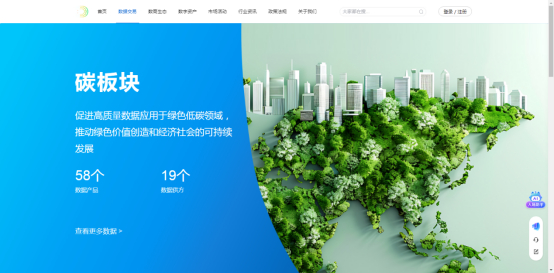Shanghai Data Exchange launches carbon sector
In the process of achieving the "double carbon" goal, the importance of carbon data has become increasingly prominent. Recently, the Shanghai Data Exchange officially launched the carbon sector. This section focuses on data circulation and trading in the green and low-carbon field, gathers carbon emission data, focuses on expanding core scenarios such as green finance and carbon emission management, and opens up data circulation and trading links in the green and low-carbon field.

The reporter saw on the official website of the Shanghai Data Exchange that as of now, there are 58 data products related to the carbon sector and 19 data providers. 58 data products, including Ouye Yunshang's "Supply Chain Carbon Treasure", Yitong International's "Yitong Carbon Digital Treasure", and Deloitte Wind Intelligence's "Deloitte ESG Evaluation Data", have been listed in the carbon sector. The Shanghai Data Exchange divides the "green and low-carbon" sector into five types, namely ecological and environmental governance, energy utilization, waste resource utilization, carbon emission management and green finance. Currently, there are data products to choose from under each type.
According to the Shanghai Data Exchange, by concentrating these data products on the carbon sector, we hope to rely on scenarios to enrich the supply side, coordinate upstream and downstream ecosystems, and build a data market for efficient circulation and transactions.
In practice, data products in the green and low-carbon field have proved their extensive cross-industry applications and have significant practical value in fields such as green finance, green trade, and green supply chains.
In the field of green finance, more and more financial institutions are currently developing green bonds, green funds and other products based on carbon emission data, thereby providing support for low-carbon technologies, projects and enterprises. On the other hand, investors are increasingly inclined to use carbon data as a tool to assess the development status of enterprises, so as to better grasp investment risks and opportunities in the ESG (Environmental, Social and Governance) field.
In international trade, the EU Carbon Border Adjustment Mechanism (CBAM) requires exporting companies to declare relevant process information and carbon emission data of exported products quarterly for high-carbon leaking industries such as steel, aluminum, fertilizers, cement, hydrogen and electricity and upstream and downstream products. Carbon tariffs are used to impose additional taxes and fees on high-carbon emission products to achieve environmental protection goals, and carbon data calculation is the basis for its evaluation.
In the construction of green supply chains, companies need comprehensive and accurate data for product life cycle management and optimization, and reduce waste and emissions in the production process. Therefore, there are high requirements for the quality of carbon data. Green supply chain carbon emission management includes multiple types of data such as upstream product processes, specifications, and equipment. The industry needs to promote the circulation and trading of upstream and downstream data elements in the supply chain, drive the industrial chain to reduce emissions more efficiently, and achieve a dynamic balance between economic benefits and carbon emission reduction.
The Shanghai Data Exchange stated that in the future development, the "dual carbon" strategy will continue to lead the direction of sustainable development in China and the world. The Shanghai Data Exchange will focus on building a service system of "one platform, one space, one market" to thereby open up data circulation and trading links in the green and low-carbon field.







